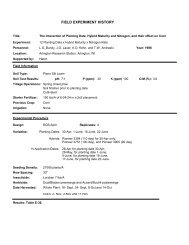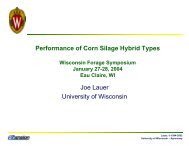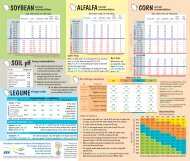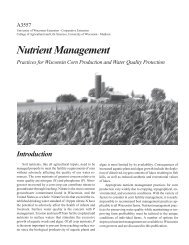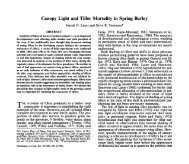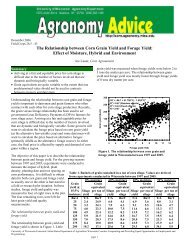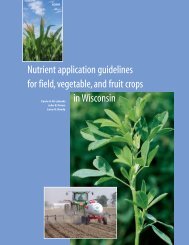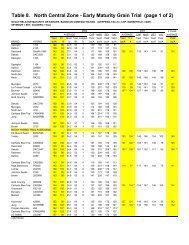Irrigation Scheduling for Corn - Wisconsin Corn Agronomy
Irrigation Scheduling for Corn - Wisconsin Corn Agronomy
Irrigation Scheduling for Corn - Wisconsin Corn Agronomy
- No tags were found...
You also want an ePaper? Increase the reach of your titles
YUMPU automatically turns print PDFs into web optimized ePapers that Google loves.
NATIONALCORNHANDBOOKWATER MANAGEMENT (IRRIGATION)<strong>Irrigation</strong> <strong>Scheduling</strong> <strong>for</strong> <strong>Corn</strong>—Why and HowF. M. Rhoads, University of Florida; and C. D. Yonts, University of NebraskaNCH-20ReviewersJ. E. Hook, Georgia Coastal Plain Experiment Station, GAS. Kincheloe, International Minerals & Chemical Corp., GAW. I. Segar, University of Georgia<strong>Irrigation</strong> scheduling is a planning and decisionmakingprocess, the primary decision being: howmuch water to apply and when to apply it.How much water to apply depends on (1) the soil’savailable moisture storage capacity and (2) the amountof available water depleted from the soil profile by cropwater use. (Soil moisture storage capacity, as explainedlater, is determined by available-water holdingcapacity of the soil and crop rooting depth.) When toapply irrigation water depends on rate of water use bythe crop and the total available soil moisture.This publication deals with the why’s and how’s ofcorn irrigation scheduling. Discussed are the potentialbenefits of proper scheduling; the crop, soil, andclimatic factors involved and their relationships;methods of determining irrigation timing; and schedulingconsiderations unique to different climatic regions.VALUE OF IRRIGATION SCHEDULINGThe main objective of irrigation scheduling is tomanage irrigations <strong>for</strong> greatest effectiveness. Properscheduling will minimize yield loss due to crop waterstress, maximize yield response to other managementpractices, and optimize yield per unit of water applied(irrigation efficiency)—all of which contribute toprofitability.<strong>Scheduling</strong> that results in either excessive orinadequate water application can significantly reducethe potential <strong>for</strong> profitability. For instance, overirrigationduring the growing season may eliminatecrop water stress, but it will also lessen irrigationefficiency and yield response to other managementpractices, such as fertilization, planting date, populationand weed control. Inadequate irrigation, on theother hand, results in crop water stress and less yieldresponse to other management factors, even thoughirrigation efficiency remains high because runoff anddeep percolation are reduced.FACTORS AFFECTING IRRIGATIONSCHEDULINGKnowing when and how much to irrigate isdetermined primarily by four factors—availability of thewater in the soil, water needs of the crop, value of anyrainfall and actual output of the irrigation system. Theeffect of each factor and how to assess it are discussedin the following paragraphs.Soil, Water and Plant RelationshipsSoils are diverse and require different watermanagement techniques. For instance, their texturalcharacteristics dictate the water holding capacity,intake rate, and drainage rate. Table 1 gives theavailable-water holding capacities of ten different soiltypes. Soils also differ as to depth adequate <strong>for</strong> activeroot development; some have underlying layers ofgravel or had pan that would restrict root growth.Soil is like a sponge in that “squeezing” waterfrom it is easy at first but becomes more difficult aswater is removed. That’s just what the corn plantexperiences as it grows. When the soil profile is full,the plant expends little ef<strong>for</strong>t to obtain water; but assoil moisture becomes depleted, more ef<strong>for</strong>t is requiredto meet the plant’s water demands.The water content of a soil after being saturatedby rainfall or irrigation and allowed to drain is calledfield capacity. The point at which a crop can no longertake water up from the soil is called the permanentwilting point. The water held by the soil between fieldcapacity and the permanent wilting point is consideredavailable water. <strong>Corn</strong> is capable of using 50percent of the available water stored in the soil be<strong>for</strong>eplant stress begins.NCH 20 Reprinted September 1991Electronic version October 2000
Table 1. Available-Water Holding Capacity of TenSoil Types.StorageSoil Type Textural characteristics capacityin./ft.0 Sandy clay loam 2.01 Silty clay loam 1.82 Clay loam 1.83 LoamLow (2%) Very fine sandy loam 2.0O.M. Silt loam4 LoamHigh (3%) Very fine sandy loam 2.5O.M. Silt loam5 Fine sandy loam 1.86 Sandy loam 1.47 Loamy sand 1.18 Fine sands 1.09 Silty clayClay 1.6Soil can be viewed as a reservoir that holdsmoisture <strong>for</strong> plant use. The capacity of the reservoir<strong>for</strong> a particular soil type is determined by multiplyingthat soil’s available-water holding capacity (Table 1)by the crop rooting depth.Maximum allowable depletion of the soil reservoiris reached when water must be added to prevent cropstress (which <strong>for</strong> corn is when it has used half thestored water). The allowable depletion point increasesduring the season as roots grow deeper, thus enlargingthe soil reservoir. Table 2 presents the estimatedmaximum moisture deficiency levels <strong>for</strong> the ten soiltypes in Table 1 at various crop rooting depths.Although corn root depth early in the season isshallow, moisture must nevertheless be available inthe eventual root profile to assure good root development.When actively growing, corn obtains 90 percentof the water it uses from the top 3 feet of the soil profile.The normal root depth of corn at various stages ofgrowth is shown in Table 3. By knowing both corngrowth stage and soil type, an irrigator can determinefrom Tables 1 and 3 the soil’s total water holdingcapacity and, from that, the maximum amount ofwater to apply at one time if the soil moisture level isdepleted.For example, a sandy loam (see Table 1) whencorn is at silking (see Table 3) has a total waterholding capacity of 4.2 inches (1.4 in water/ft. soildepth x 3.0 ft root depth). Since only 50 percent ofthat capacity can be used by the corn be<strong>for</strong>e stresswill begin, the maximum allowable depletion would be2.1 inches of water (4.2 in. x .5).Crop Water DemandWater is absorbed from the soil, transportedthrough the plant, then lost to the atmosphere by aprocess called transpiration. Evaporation from the soilsurface combined with transpiration is called evapotranspiration.The evapotranspiration rate depends on temperature,humidity, wind, solar radiation, and total leaf areaof the crop. When temperature is relatively low andhumidity is high as on a calm, cloudy day, the evapotranspirationrate will be low. If temperature is highand humidity low as on a sunny, windy day, the ratewill be high.Under similar environmental conditions, a small,young plant with little leaf area and limited root systemwould require much less water than a mature plantwith its large leaf area and dense root system, 75percent of which is in the top 12 inches of soil. Theeffect of plant size on crop water demand is illustratedin Figure 1.Rainfall ValueRainfall usually reduces the requirement <strong>for</strong>irrigation. However, not all rainfall can be consideredeffective; thus, estimates are needed to determine itsvalue.Table 2. Maximum Allowable Moisture Depletion of Ten Soil Types at Various Root Depths.Soil type (see Table 1)Rootdepth 0 1 2 3 4 5 6 7 8 9feetinches1.5 1.5 1.4 1.4 1.5 1.9 1.4 1.0 0.8 0.8 1.22.0 2.0 1.8 1.8 2.0 2.5 1.8 1.4 1.1 1.0 1.62.5 2.5 2.2 2.2 2.5 3.1 2.2 1.8 1.4 1.2 2.03.0* 3.0 2.7 2.7 3.0 3.8 2.7 2.1 1.6 1.5 2.4* For corn, 75 percent of available soil moisture may be removed after dough stage of growth whenmonitoring a 3-foot depth.2
Table 3. Average Root Depth of <strong>Corn</strong> at VariousStage of GrowthAssumedStage of corn developmentroot depth*feet12-leaf 2.0Early tassel (16-leaf) 2.5Silking 3.0Blister 3.5Beginning dent 4.0*Root development may be restricted to a depth lessthan that shown due to compaction or limiting layers.Rainfall can be lost from the soil in two ways—runoff and deep percolation. Runoff occurs when therainfall rate exceeds the soil’s infiltration rate. Lowrates of rainfall over an extended period of time willoften replenish the soil without runoff. Water is lost bydeep percolation when rainfall exceeds the soil’s totalwater holding capacity. Because rainfall is highlyvariable, measurements should be taken near thefields scheduled <strong>for</strong> irrigation.A small amount of precipitation has little effect onirrigation water management. However, rainfall sufficientto fill much of the root zone will place an irrigation schedulein a start-over mode; and unless the schedule isreestablished, over-irrigation of a portion of the field(s)scheduled may result. With a center-pivot irrigationsystem, this problem can be successfully dealt with byvarying the amount of water applied around the field.Gravity irrigation systems, un<strong>for</strong>tunately, do notallow this flexibility; and irrigation must be started basedon the last portion of the field(s) to be irrigated. Thus,during high water-use periods, when crop water demandequals system capacity, precipitation will likely resultWATER USE (IN./DAY)0.40.30.20.100 20 40 60 80 100DAYS AFTER PLANTINGFigure 1. Water use by the corn plant in the first100 days after planting calculated from rainfall andirrigation.in over-irrigation. Delaying irrigation to avoid this,however, could lead to crop stress later in the season.The best guide <strong>for</strong> determining the effectiveness ofprecipitation is to consider soil type together with rainfallintensity. For example, there will be runoff from a highintensityrain much sooner on a fine-textured soil thanon a coarse-textured soil. Rainfall, like soil type, can varygreatly in short distances, making them both very sitespecificfactors. Thus, precipitation should be measuredin the immediate location of the field scheduled andestimates made of the efficiency of each rainfall.The irrigator should take advantage of rainfall whenpossible, and remember that accurate measurement isthe primary way to determine its value.Measurement of <strong>Irrigation</strong> WaterPeriodic calibration with flow-measuring devices isimportant to ensure that desired irrigation water applicationrates are being realized. The output rate of an irrigationsystem is a critical factor <strong>for</strong> scheduling and mustbe known because it determines how long the systemhas to operate to apply the desired amount of water.For sprinkler-type irrigation systems, flow metersor rain gauges should be used to measure waterapplied. Straight-sided cans make inexpensive raingauges and, if set out in sufficient numbers, will alsohelp determine sprinkler uni<strong>for</strong>mity. For furrow irrigationsystems, flow meters at the pump or weirs in thedelivery canal should be used.METHODS OF TIMING IRRIGATIONAs already discussed, a soil’s water holdingcapacity indicates both amount of water available <strong>for</strong>plant use and maximum allowable depletion. Thus, todetermine when irrigation is needed (i.e., whenmaximum allowable depletion would be reached), onemust know how much water is in the soil reservoir atany given point in time.There are a number of ways to make this estimate.The most common ones are discussed hereand can be used regardless of soil type.Feel MethodThe feel method is one of the oldest ways todetermine amount of soil moisture. As water contentchanges, the “feel” of soil changes. With experience,some people can calibrate their sense of touch toestimate available soil water. Table 4 describes theappearance and feel of sandy, loamy, and clayey soilsat various moisture content levels.The only instrument needed <strong>for</strong> employing thistechnique is an inexpensive hand probe long enoughto reach down through the full root profile. However,although simple to use, the probe-feel method allows<strong>for</strong> only approximate soil moisture values. (Whenusing any stationary soil moisture measurementdevice, a soil probe is recommended <strong>for</strong> doublechecking equipment operation and confirming moisturevalues in other areas of the field.)3
Table 4. Visual and Textural Characteristics of Three Soil Classifications at Various MoistureContents.Soil classificationPct. availablewater Sandy Loamy Clayey0 Dry, loose, flows Powdery, dry Hard, baked,through fingerscrackedAppears dry, will Crumbly, but Pliable, will50 or less not <strong>for</strong>m a ball will hold together ball underunder pressure from pressure pressureTends to ball Forms ball, Forms ball,50 to 75 under pressure slightly plastic, pliable, slicksbut does not will slick slightly readilyhold togetherwith pressureForms weak ball, Forms ball, will Easily ribbons out75 to 100 breaks easily, ribbon out between between fingers,will not slick thumb and <strong>for</strong>efinger has slick feelingElectrical ConductivityElectrical resistance blocks measure soil watermore precisely than the feel method. Small blocks madefrom plaster of paris (gypsum), nylon, fiberglass, orother material containing electrodes are buried in thesoil with wires extending to the surface. An electricalmeter touching the wires measures the change inelectrical resistance during wetting and drying cycles.The blocks, which can be used only one season,are placed at four locations or stations in a field. Ateach station, three blocks are buried at 0.5-, 1.5-, and2.0-foot depths.With a gravity irrigation system, one stationshould be at the top and one at the bottom of the fieldin both the first and last irrigation sets. With a centerpivotsystem, there should be two stations on eachside of the normal stop position, all accessible fromthe pivot roadway. Of the two on each side of the road,one should be near the center and other near theouter edge of the pivot. Flag the location of anyinstruments used in fields so they can be found easily.The electrical conductivity method is recommendedon the finer-textured soils.TensiometersTensiometers are mechanical instruments thatmeasure soil water suction, as shown in Figure 2.They can be used successfully <strong>for</strong> scheduling irrigationsif the relationship between soil water suction andavailable water <strong>for</strong> a particular soil is known.Tensiometers are recommended <strong>for</strong> use on loamysands and fine sands. Their placement and thenumber of stations in a field are the same as <strong>for</strong>electrical resistance blocks.Neutron Moisture ProbeA neutron probe measures soil water contentusing a radioactive source. The instrument itself andthe access tubes (which require installation) are quiteexpensive. There<strong>for</strong>e, the neutron probe method isused mostly <strong>for</strong> research and by some irrigationconsulting firms that measure large numbers of fields.It is not recommended <strong>for</strong> small-scale irrigationscheduling.Evaporation PansEvapoation pans may be used to calculate theamount of water utilized by the crop. The pans canPERCENT WATER IN SOIL302010FIELD CAPACITYCLAY LOAMSANDY LOAMWILTING POINTAVAILABLE WATERAVAILABLE WATER40 5 10 15SOIL WATER SUCTION (BARS)Figure 2. Relationship between soil water suctionand percent water <strong>for</strong> clay loam and sandy loam soiltypes.4
serve wide areas, but calibration is required based ona crop coefficient to relate evaporation rate to actualwater use. The coefficient is the ratio of potentialevapotranspiration (water loss from both crop and soilsurface) to pan evaporation.During the early part of the growing season, thecrop coefficient is less than 0.5 but approaches 1.0 asthe crop canopy closes. For example, if the cropcoefficient is 0.3 and 1 inch of water evaporates fromthe pan, crop water use would be 0.3 inch.Computer ProgramsComputer programs have been developed <strong>for</strong>scheduling irrigation, and they use meteorologicaldata to calculate water use. The computer <strong>for</strong>ecaststhe timing and amount of irrigation water necessary<strong>for</strong> optimum crop production.Computer irrigation scheduling is available fromcomputer networks that provide scheduling programs<strong>for</strong> a service fee. There are also similar programs <strong>for</strong>personal computers and hand-held calculators thatmay be purchased.Water BudgetingWater budgeting is a method used to balance theavailable soil moisture. Rainfall and irrigation amountsrepresent credit entries, whereas evapotranspirationis a debit entry. Rainfall and irrigation should bemeasured as previously discussed. Evapotranspirationcan be estimated from evaporation pan data, fromweather data obtained at a nearby weather station, orfrom in<strong>for</strong>mation available through local agencies thatcalculate crop water use.The critical value in water budgeting is soil waterholding capacity. Fifty percent of this value is themaximum allowable depletion level, and 50 percent isthe maximum application amount.A good starting point <strong>for</strong> a water budget system iswhen the soil water level is at field capacity. Thisallows the center-pivot irrigator to follow a replacementschedule whereby any water used by the plantis replaced through irrigation or rainfall.Water budget scheduling also provides watermanagement <strong>for</strong> the gravity irrigator. Plant water usecan be estimated from any of the sources notedabove. Since the soil profile is normally filled witheach irrigation, soil water holding capacity can serveas a guide to determine amount of water available.When water used equals the maximum allowabledepletion, irrigation is needed.An example water budget balance sheet <strong>for</strong> cornis presented in Figure 3.IRRIGATION SCHEDULING IN DIFFERENTCLIMATIC REGIONSHumid and Subhumid Region <strong>Scheduling</strong>The high probability of precipitation makesscheduling irrigation in humid regions difficult.Chances of over-irrigation are high because of thegreater likelihood of summer rains. Rainfall usuallysupplies the major part of a crop’s water requirementin these regions and should be used to the full extent.Since the chances are good of rainfall occurringshortly after irrigation, it is advisable to not rechargethe complete root zone. This not only reduces irrigationcosts, but also minimizes nutrient leaching.Research on a variety of soil types has shown thatcorn yields of 150-200 bushels per acre can beobtained by recharging just the top 8-12 inches of thesoil profile.Mobile sprinkler systems, such as traveling gunsand center pivots, require an extended period of timeto cover the irrigated area. This poses no problem aslong as the irrigation cycle is not interrupted byrainfall. Sufficient amounts of rain uni<strong>for</strong>mly rechargethe soil to field capacity over the entire irrigated areasimultaneously.If the available soil water is permitted to reach themaximum allowable depetion level following rain, aportion of the field will likely experience considerablewater stress be<strong>for</strong>e the irrigation cycle is completed.This problem can be minimized by (1) starting thesystem when half of allowable depletion occurs and(2) applying half the normal water rate (which shouldallow the abbreviated cycle to be completed in half thenormal time). Such a procedure re-establishes theirrigation cycle without subjecting part of the crop toexcessive stress.Arid and Semiarid <strong>Scheduling</strong>Depending on soil type, expected early precipitationor irrigation at planting normally meets the corncrop’s water demand during the spring in arid andsemiarid regions. Then as reserve moisture is used,irrigation becomes the primary means <strong>for</strong> plantgrowth.<strong>Scheduling</strong> irrigation <strong>for</strong> corn during high wateruseperiods may seem unnecessary if an irrigator is atbest marginally capable of keeping up with cropdemands due to either low system capacity or watersupply and/or cost restrictions. In such cases, alogical schedule during peak water use is probably toirrigate continually, unless there are rainstorms ofsufficient number or intensity <strong>for</strong> the soil profile to“catch up.” <strong>Scheduling</strong> will then determine if continuedirrigation is needed should that precipitation occur.In most cases, scheduling in the arid areasprovides the greatest return during spring and fall.As the name implies, arid and semiarid regionshave low probabilities of precipitation. There<strong>for</strong>e,irrigators should plan to fill the soil profile duringirrigation rather than leave room <strong>for</strong> possible rain.Water use can average above .25 inch a day duringthe summer, which means over 1 inch of soil moisturedepletion in only 4 days.It is important to keep ahead of crop demandrather than to risk falling behind trying to leave room<strong>for</strong> low-probability rainfall. The exception to thisoccurs in the fall when crop water demand is on itsdownward trend.5
Field soil type: Fine sand.Soil available-water holding capacity: 1.0 inch per foot (from Table 1).Maximum available profile moisture: 2.0 inches from seedling to 12-leaf stage; 3.0 inches from 12-leaf stage tomaturity. a Weekly b Weekly Weekly Weekly c Actual devapotran- rain- irri- moisture profileWeek Growth stage spiration fall gation balance moistureinches/acre1 Seedling 0.4 1.5 0 +1.1 2.02 2 to 4 leaf 0.4 0 0 -0.4 1.63 4 to 6 leaf 0.6 0 0 -0.6 1.04 6 to 8 leaf 0.8 1.2 0 +0.4 1.45 8 to 10 leaf 1.1 0 1.0 -0.1 1.3 *6 10 to 12 leaf 1.4 0 1.5 +0.1 1.47 12 to 14 leaf 1.4 0 1.4 0 2.4 e8 14 to 16 leaf 1.5 2.3 0 +0.8 3.0 f9 Pollination 2.3 3.0 0 +0.7 3.010 Pollination 2.3 0 1.0 -1.3 1.7 *11 Grainfilling 1.8 0 2.0 +0.2 1.912 Grainfilling 1.8 0 2.0 +0.2 2.113 Grainfilling 1.8 0 2.0 +0.2 2.314 Grainfilling 1.7 1.5 0 -0.2 2.115 Grainfilling 1.7 1.0 1.0 +0.3 2.4 *16 Maturity 1.6 0 1.5 -0.1 2.317 Maturity 1.6 0 1.0 -0.6 1.7a Maximum available profile moisture = soil available-water holding capacity (from Table 1) x approximate plant root depth at various growthstages (from Table 3).b Evapotranspiration = water used by the plant (see Figure 1) + water lost to the atmosphere (estimated). Values will vary with location and year.c Moisture balance = (rainfall + irrigation) - evapotranspiration.d Profile moisture = Previous week’s profile moisture + present week’s moisture balance.e This 1 inch increase in profile moisture from the previous week is due to the additional foot of root depth as corn passes the 12-leaf stage.f The week’s +0.8 inch moisture balance added to 2.4 inches already in the profile totals 3.2 inches. However, 3.0 inches is the profile maximum,which means the excess water drained below the root zone.* Usually, irrigation of corn should begin when profile moisture falls below the soil’s maximum allowable moisture depletion (from Table 2) andthere has been no significant rainfall. In this example, that point is 1.0 inch up to the 12-leaf stage and 1.5 inches after the 12-leaf stage.Figure 3. Example of a water budgeting balance sheet <strong>for</strong> corn.SUMMARY<strong>Corn</strong> adapts well to furrow, sprinkler, and traveling-gunirrigation; and all three systems are equallyadaptable to irrigation scheduling. Center pivot is anexcellent system <strong>for</strong> applying different amounts ofwater during the growing season uni<strong>for</strong>mly across afield.When scheduling sprinkler, traveling-gun, orcenter-pivot irrigations, the potentially high rate ofevaporation should be taken into account to determinesprinkler efficiency. The easiest way to measuretotal water applied is catch cans placed at severallocations in the field. Flow meters will provide data ontotal water pumped but not on application efficiency.Properly managed furrow irrigation can apply arelatively uni<strong>for</strong>m amount of water. However, applicationof small amounts may not be feasible with thissystem because of the labor input required <strong>for</strong> eachirrigation. Thus, furrow irrigations are normally madewith the intent of filling the soil profile, using set timesof 8-12 hours. Under these conditions, the soil profileshould be near the 50 percent depletion level whenirrigation begins.. . . and justice <strong>for</strong> allThe U.S. Department of Agriculture (USDA) prohibits discrimination in all itsprograms and activities on the basis of race, color, national origin, gender,religion, age, disability, political beliefs, sexual orientation, and marital orfamily status. (Not all prohibited bases apply to all programs.) Many materialscan be made available in alternative <strong>for</strong>mats <strong>for</strong> ADA clients. To file acomplaint of discrimination, write USDA, Office of Civil Rights, Room 326-W,Whitten Building, 14th and Independence Avenue, SW, Washington, DC20250-9410 or call 202-720-5964.Issued in furtherance of Cooperative Extension work, Acts of May 8 and June30, 1914, in cooperation with the U.S. Department of Agriculture. Stanley R.Johnson, director, Cooperative Extension Service, Iowa State University ofScience and Technology, Ames, Iowa.File: <strong>Agronomy</strong> 2-2





